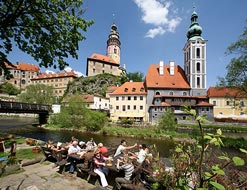
Let's take a seat at the oak table
and pause on how we can be inspired
by the diet of our ancestors.
Was old Czech cuisine healthy?
Was the diet of the poor really poor?
Can we have a similar diet as our ancestors?
Gruels prevailed in the diet of our ancestors for ages - porridge, millet, peeled barley, buckwheat, wheat, maize pea or fruit gruels, peas pudding. Sweet or salt gruels, mild or roughly ground, groats or grits. On lords' tables there were gruels richly greased with butter; sweetened with honey, seasoned with safron, ginger, rose petals and spicery from far-away countries, boiled with wine or cream, with nuts and almonds. In folk cuisine there were gruels poured with milk and sweetened with dried pears or as salty gruels with sauerkraut and greased with fat. Our mushroom millet gruel is mentioned in a cookery book from a monastery in Strahov in Prague from the second half of the 17th century.
Pancakes or unfermented bread are traditional healthy meals there. You need only a bit of flour and water and if need be also some spicery according to your fantasy and taste. Pancakes made from wholemeal wheat, rye or oat flour will be different from pancakes made from maize or buckwheat. In the 19th century potatoes became domesticated in this country and potato pancakes baked on the cooking range became very popular. But gruels and pancakes were pushed back by bread from our ancestors' diet and some traditional cereals had to recede to bread cereals - wheat and rye.
Our ancestor's kitchen was full of the sweet smell of spicery. In the lords' kitchens there were various kinds of sweet smells from far-away countries - safron, ginger, vanilla, pepper... Village housewives used to improve the taste and palatability of meals with herbs frorn their own gardens. We could find there marjoram, basil, calamint, dittany, sage, rosemary, cow parsley, caraway, yellow wormwood ... Herbs crown the character of the meal and improve health by means of plentitude of minerals and vitamins. Nowadays we rediscover the importance of sprouted seeds, which belonged to spring sources of vitamins. In South Bohemian cuisine fried peas (made from sprouted and roasted peas) were used for a long time.
We would like to enrich your diet with our offer of traditional meals made from partly forgotten crop plants such as buckwheat or millet as well as sweet the smell of spice from a herb garden. The diet of our modestly living ancestors was not poor.
Buckwheat - Fagopyrum esculentum
Buckwheat is a doorweed plant, although its kernel is floury likewise cereals. It probably came to Europe in the 13th century with Mongolic raids.
In the 16th century Mathioli writes in his herbarium, that there is plentitude of buckwheat in Bohemia and it is common food there. The best use of it is for cooking gruels, which were made by our ancestors in many ways as salty or sweet ones. In lordly cuisine it was cooked for example with honey and was flavoured with elder flower and rose flower with cherry and plum kernels. In plod cottages people simply poured milk on it. Somewhere they added it into bread dough, but bread canot be made from buckwheat only. In the 20th century gruel was pushed back by bread from our ancestors 'diet. Buckwheat (together with millet) had to recede to bread cereals - wheat and rye. Nowadays buckwheat returns into our cuisine. It is appreciated for its high contents of easily digestible proteins, favourable composition of oil and alkaloid rutin, which increases elasticity of vessels and detracts from a cholesterol level in blood. Buckwheat raises sexual functions. It is warming food, that's why it tastes namely in cool days.
Milled - Panicum miliaceum
Milled is one of the oldest cereals in Europe and Asia. Since old ages it was basic food in Old China, antique authors mentioned it, millet peels are found in Germany in archeological finds from the first centuries AD .. Millet was used as charitable gift put into the graves. According to the reports from the 9th and 10th centuries millet was cereal typical for the Slays and Mathioli confirms its common using in his herbarium from the 16th century. Peeled millet was mostly used for making gruels. Even in the 20th century wedding feasts in some parts of Moravia finished with millet gruel. People believed, that richness of small grains in millet can ensure prosperity to the newly-weds. In the 20th century millet together with buckwheat had to recede to bread cereals.
Millet is rich in phosphorus and other minerals, namely iron. It is digestible very well. It is very suitable for children and it can be recommended when there is some allergy. Millet is widely used in hotplate as well as cold meals. Boiled millet can be used for gruels, balls, cookies, puddings, sweet and salty millet gruels, pereads or sweet creams.
Herbage - spice and teas
Basil - Ocimum basilicum
Particularly multi-purpose herb. It harmonizes digestion, takes effect as remedy an inflammation, it is good for heart, nerves, good sleep and comfort. It was used in Medieval Europe to rid people of the witches.
Tarragon - Artemisia dracunculus
It improves appetite and digestion. It rids people of hiccough. the Franconian king Karloman ordered all the monasteries and gardens to grow tarragon - since the time this herb is very popular in France. It was used as remedy snakebite.
Lovage - Levisticum officinale
It cleans body from settled salts, helps a chill, and is good for digestion. People bind it with love affairs.
Common Nasturtium - Tropaeolum majus
One of the most useful herbs. It improves immunity, it is antibiotic, helps hair falling. We can eat fresh leaves, blossoms, buds as well as unripe seeds. They say Egyptian pharaohs gave nasturtium juice to the slaves to increase their productivity.
Common Lime - Tilia vulgaris
Lime-blossom tea is a well-tried means to increase perspiration when there is a cold. It calms the heart when there is stress, rids people of fear and pressure.
Marjoram - Majorana hortensis
One of the most important spices in Czech cuisine. It improves digestion, suppresses flatulence, takes effect as remedy an inflammation and infection, gently calms. Its brew-up rids of fatigue.
Peppermint - Mentha piperita
Calming as well as warming. It suppresses pain with its relaxing effect, takes effect as remedy an inflammation. Arabian men improve by means of peppermint tea their virile strength and contract friendship.
Balm - Melissa officinalis
Ancient tonic, which improves mood and calms mind. It is good for sleeplessness and depressios. It is useful during pregnancy and lactation. Balm wine can strengthen the heart and the brain and clear the chest and respiration.
Marigold - Calendula fficinalis
It comforts the heart and heals the body. It heals wounds and smoothes the skin. It increases resistance of the nervous system. In England this flower was consecrated to Virgin Mary.
Rue - Ruta graveolens
It benefits a gallbladder and digestion, makes blood vessels more elastic and harder. It helps the dizziness. Smell of fresh rue is said to help people in love to keep their minds clear. It was used for fumigation and when carried on one's neck it protected from bugbears, vampires and witches.
Rosemary - Rosmarinus officinalis
It improves digestion and mental and physical condition. Rosemary wine gets blood pressure higher. Rosemary is a superb magical herb - its digestion releases powerful purgative vibrations. When given under the bed it protects the sleeper from all the evil things.
Savory - Satureia hortensis
It benefits a gallbladder and digestion, disinfects and heals, reduces blood pressure. It benefits an excessive thinness. It is a tonic. When carried on one's neck it is said to tonic one's mind.
Daisy - Bellis perennis
It helps a cough, heals and cleans the skin, calmss. It gives warmth of home to the teas and meals. The Czech healer Father Ferda gives advice to eat seven daisies when there is a headache.
Sage - Salvia officinalis
It reduces perspiration; it is an antibiotic and a good gargle. Old Slovene recipe for diabetes recommends to eat 5 - 7 fresh sage leaves during a day.
Common Thyme - Thymus vulgariss
It disinfects respiratory organs and improves digestion. They burn common thyme when magically clearing space.



